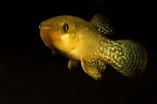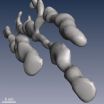(Press-News.org) PORTLAND, Ore. — A team led by an Oregon Health & Science University researcher has sequenced and annotated the genome of the only ape whose DNA had yet to be sequenced — the gibbon, an endangered small ape that inhabits the tropical forests of Southeast Asia.
The team's work, published in the Sept. 11 edition of Nature, gives scientists new insight into the evolution of the gibbon genome and its extraordinary number of chromosomal rearrangements. Chromosomal rearrangements are structural changes in the DNA that are often problematic in other species — including causing cancer in humans — but seem to have happened in gibbons at a very high frequency. The genome sequencing work also provides new details on the family tree and evolutionary history of the gibbon lineage that has been a longstanding source of debate. Additionally, the team uncovered some genetic clues on how gibbon species over millions of years developed longer arms and powerful shoulder and arm tendons — important for these tree-dwelling primates whose main mode of locomotion is swinging from tree to tree in the dense tropical forest.
Finally, like the DNA sequencing of other apes and non-human primates, the team's work gives science new insight into the human genome — since apes are so genetically similar to humans. Unraveling primate genomes is vitally important as researchers try to understand the genetic factors in human health and disease.
"We do this work to learn as much as we can about gibbons, which are some of the rarest species on the planet," said Lucia Carbone, Ph.D., assistant professor of behavioral neuroscience in the OHSU School of Medicine and an assistant scientist in the Division of Neuroscience at OHSU's Oregon National Primate Research Center. "But we also do this work to better understand our own evolution and get some clues on the origin of human diseases."
Carbone worked on the project for more than two years, in collaboration with scientists at the Human Genome Sequencing Center at Baylor College of Medicine in Houston, Texas, and The Genome Institute at Washington University in St. Louis, Missouri. Other collaborators on the project included scientists from the University of Arizona, the University of Washington and international labs from Spain, Italy and Germany.
Gibbons, together with the other apes — orangutans, gorillas, chimpanzees and bonobos — are the closest relatives to humans. Humans and these apes all belong to the "superfamily" called Hominoidea.
But unlike other apes and humans, gibbons have undergone a high number of chromosomal rearrangements as they have evolved.
"You might think about chromosomes as constructions made of different plastic toy bricks. In the rearrangement, one or more toy pieces separate from the others and reattach in a different orientation or location. Or, they might get lost or duplicated," said Carbone. "We know that these types of events have been occurring in the other apes, including humans, but gibbons show a much higher frequency. One of our goals while analyzing the genome was to try to identify the cause of this instability."
Such chromosomal rearrangements can cause major problems in cells, and can contribute to birth defects and cancer in humans. But they seem to have been well tolerated by gibbons. The gibbon genome will now be a tool to better understand the mechanisms behind these "errors."
In particular, the analysis of the gibbon genome exposed an intriguing role for a new repetitive DNA sequence that emerged exclusively in the gibbon genome. It's called the "LAVA" element and more than one thousand copies have been found in the gibbon genome. Several LAVA elements have been inserted in a group of genes that are important for guaranteeing the correct separation of chromosomes when cells divide.
"The LAVA element is an evolutionary novelty that is only present in the DNA of gibbon species," Carbone said. "We think that it played a major role by increasing the 'errors' during cell division and chance for chromosomal rearrangements."
Interestingly, many of the genes impacted by the LAVA element in gibbons are mutated in some types of tumors in humans. The gibbon genome project shows that by understanding how evolution experiments with genomic rearrangement, we might then be able to apply that knowledge to human health.
"This is the last ape to be sequenced and the end of an era in human comparative genomics," said Tomas Marques-Bonet, evolutionary geneticist at Institut de Biologia Evolutiva (CSIC/UPF) and the National Center of Genomic Analysis (CNAG) in Barcelona, Catalonia, Spain, and co-author on the paper. "Now we have tools — the genomes — for all the closest species to humans."
As part of the project, the team sequenced the whole genome of eight different gibbon species using next-generation sequencing and revealed more about the order in which the four different gibbon genera — or a group of species — diverged from each other. While in most cases it is possible to determine the order in which different species diverged from each other, this is not the case for gibbons. Evolutionary biologists within the team found that the four gibbon genera diverged almost instantaneously about four million years ago. That prevents scientists from determining the order in which they separated from each other.
Around that time, there were major changes in the tropical and subtropical forests and significant shifts in sea levels in the territory occupied by the gibbons. Those geographical changes likely contributed to the rapid divergence of the gibbon genera by generating isolation between groups. Isolation is one of the major forces to drive the rise of new species.
"We hope that by learning more about the genome of these species we will also be able to implement better strategies for their conservation — as some of these species are critically endangered and about to disappear," Carbone said.
INFORMATION:
The gibbon genome project was funded by the National Human Genome Research Institute, including grants U54HG003273 andU54 HG003079, with further support from National Institutes of Health (grants NIH/NIAAA P30 AA019355 and NIH/NCRR P51 RR000163). Other funding agencies included the National Science Foundation, the Howard Hughes Medical Institute and the European Research Council. The work was possible thanks to contributions from the Gibbon Conservation Center in Santa Clarita, California.
ABOUT OHSU
Oregon Health & Science University Is a nationally prominent research university and Oregon's only public academic health center. It serves patients throughout the region with a Level 1 trauma center and nationally recognized Doernbecher Children's Hospital. OHSU operates dental, medical, nursing and pharmacy schools that rank high both in research funding and in meeting the university's social mission. OHSU's Knight Cancer Institute helped pioneer personalized medicine through a discovery that identified how to shut down cells that enable cancer to grow without harming healthy ones. OHSU Brain Institute scientists are nationally recognized for discoveries that have led to a better understanding of Alzheimer's disease and new treatments for Parkinson's disease, multiple sclerosis and stroke. OHSU's Casey Eye Institute is a global leader in ophthalmic imaging, and in clinical trials related to eye disease.
ABOUT ONPRC
The Oregon National Primate Research Center is one of the eight National Primate Research Centers supported by the NIH. ONPRC is a registered research institution, inspected regularly by the United States Department of Agriculture. It operates in compliance with the Animal Welfare Act and has an assurance of regulatory compliance on file with the National Institutes of Health. The ONPRC also participates in the voluntary accreditation program overseen by the Association for Assessment and Accreditation of Laboratory Animal Care International (AAALAC).
Sequencing and analysis of gibbon genome sheds light on its complex evolution
OHSU researcher leads team on gibbon DNA sequencing, which will provide clues for human health research
2014-09-10
ELSE PRESS RELEASES FROM THIS DATE:
Gibbon genome and the fast karyotype evolution of small apes
2014-09-10
BATON ROUGE – LSU's Mark Batzer, LSU Boyd Professor and Dr. Mary Lou Applewhite Distinguished Professor, along with Research Assistant Professor Miriam Konkel and Research Associate Jerilyn Walker in Department of Biological Sciences in the College of Science, contributed to an article featured on the cover of the scientific journal Nature, titled "Gibbon Genome and the Fast Karyotype Evolution of Small Apes."
An abstract of the article can be found at http://www.nature.com/nature/journal/v513/n7517/full/nature13679.html?WT.ec_id=NATURE-20140911. The issue of Nature will ...
NASA sees a significant flare surge off the sun
2014-09-10
The sun emitted a significant solar flare, peaking at 1:48 p.m. EDT on Sept. 10, 2014. NASA's Solar Dynamics Observatory captured images of the event.
Solar flares are powerful bursts of radiation. Harmful radiation from a flare cannot pass through Earth's atmosphere to physically affect humans on the ground. However -- when intense enough -- they can disturb the atmosphere in the layer where GPS and communications signals travel.
To see how this event may affect Earth, please visit NOAA's Space Weather Prediction Center at http://spaceweather.gov, the U.S. government's ...
Study provides more evidence that sleep apnea is hurting your brain
2014-09-10
Employing a measure rarely used in sleep apnea studies, researchers at the UCLA School of Nursing have uncovered evidence of what may be damaging the brain in people with the sleep disorder — weaker brain blood flow.
In the study, published Aug. 28 in the peer-reviewed journal PLOS ONE, researchers measured blood flow in the brain using a non-invasive MRI procedure: the global blood volume and oxygen dependent (BOLD) signal. This method is usually used to observe brain activity. Because previous research showed that poor regulation of blood in the brain might be a problem ...
Sharks more abundant on healthy coral reefs
2014-09-10
Sharks in no-fishing zones in the Great Barrier Reef (GBR) Marine Park are more abundant when the coral is healthy, according to a study published September 10, 2014 in the open-access journal PLOS ONE by Mario Espinoza from James Cook University, Australia and colleagues.
Shark species that use coral reefs may be under pressure from fishing, habitat degradation, and climate change. The authors of this study were interested in understanding the factors that affect the distribution and abundance of shark populations in the GBR, including fishing and habitat quality. To ...
Gulf killifishes' biological responses to oil spills similar in field, laboratory studies
2014-09-10
Gulf killifish biological responses to the Deepwater Horizon oil spill detected by researchers in the field are similar to those in controlled laboratory studies, according to a study published September 10, 2014 in the open-access journal PLOS ONE by Whitney Pilcher from Louisiana State University and colleagues.
After the Deepwater Horizon oil spill, scientists monitored the impacts of oil on a local species of fish, the Gulf killifish. Changes in genome expression responses to oil exposure may provide insight into how the fish are affected by or adapt to environmental ...
New study shows impact of movies on dog breed popularity
2014-09-10
The effect of movies featuring dogs on the popularity of dog breeds can last up to ten years and is correlated with the general success of the movies, according to new research from the University of Bristol, the City University of New York, and Western Carolina University.
The study, published today in PLOS ONE, also found that movies' influence was strongest in the early twentieth century and has declined since.
The researchers used data from the American Kennel Club, which maintains the world's largest dog registry totalling over 65 million dogs, and analysed a total ...
New 3-D imaging techniques may improve understanding of biofuel plant material
2014-09-10
Comparison of 3D TEM imaging techniques reveals never-seen-before details of plant cell walls, according to a study published September 10, 2014 in the open-access journal PLOS ONE by Purbasha Sarkar from University of California, Berkeley and colleagues.
Cost-effective production of plant material for biofuel requires efficient breakdown of plant cell wall tissue to retrieve the complex sugars in the cell wall required for fermentation and production of biofuels. In-depth knowledge of plant cell wall composition is therefore essential for improving the fuel production ...
New study examines impact of violent media on the brain
2014-09-10
(NEW YORK – September 10, 2014) With the longstanding debate over whether violent movies cause real world violence as a backstop, a study published today in PLOS One found that each person's reaction to violent images depends on that individual's brain circuitry, and on how aggressive they were to begin with.
The study, which was led by researchers at the Icahn School of Medicine at Mount Sinai and the NIH Intramural Program, featured brain scans which revealed that both watching and not watching violent images caused different brain activity in people with different ...
Study ties groundwater to human evolution
2014-09-10
Our ancient ancestors' ability to move around and find new sources of groundwater during extremely dry periods in Africa millions of years ago may have been key to their survival and the evolution of the human species, a new study shows.
The research – published in the journal PLOS ONE – combines geological evidence from the Olduvai sedimentary basin in Northern Tanzania, which formed about 2.2 million years ago, and results from a hydrological model.
It shows that while water in rivers and lakes would have disappeared as the climate changed due to variations in the ...
Is spooning really the best position for men with back pain?
2014-09-10
September 10, 2014 – A study using motion capture technology provides new information on the spinal strain produced by various sexual positions—suggesting that one position commonly recommended for all men with low back pain is not actually the best choice, reports a study in the journal Spine. The journal is published by Lippincott Williams & Wilkins, a part of Wolters Kluwer Health.
The results provide a more scientific basis for making individualized recommendations regarding sexual positions for men with low back pain, according to Natalie Sidorkewicz, MSc, and Stuart ...
LAST 30 PRESS RELEASES:
Heart-brain connection: international study reveals the role of the vagus nerve in keeping the heart young
Researchers identify Rb1 as a predictive biomarker for a new therapeutic strategy in some breast cancers
Survey reveals ethical gaps slowing AI adoption in pediatric surgery
Stimulant ADHD medications work differently than thought
AI overestimates how smart people are, according to HSE economists
HSE researchers create genome-wide map of quadruplexes
Scientists boost cell "powerhouses" to burn more calories
Automatic label checking: The missing step in making reliable medical AI
Low daily alcohol intake linked to 50% heightened mouth cancer risk in India
American Meteorological Society announces Rick Spinrad as 2026 President-Elect
Biomass-based carbon capture spotlighted in newly released global climate webinar recording
Illuminating invisible nano pollutants: advanced bioimaging tracks the full journey of emerging nanoscale contaminants in living systems
How does age affect recovery from spinal cord injury?
Novel AI tool offers prognosis for patients with head and neck cancer
Fathers’ microplastic exposure tied to their children’s metabolic problems
Research validates laboratory model for studying high-grade serous ovarian cancer
SIR 2026 delivers transformative breakthroughs in minimally invasive medicine to improve patient care
Stem Cell Reports most downloaded papers of 2025 highlight the breadth and impact of stem cell research
Oxford-led study estimates NHS spends around 3% of its primary and secondary care budget on the health impacts of heat and cold in England
A researcher’s long quest leads to a smart composite breakthrough
Urban wild bees act as “microbial sensors” of city health.
New study finds where you live affects recovery after a hip fracture
Forecasting the impact of fully automated vehicle adoption on US road traffic injuries
Alcohol-related hospitalizations from 2016 to 2022
Semaglutide and hospitalizations in patients with obesity and established cardiovascular disease
Researchers ‘listen in’ to embryo-mother interactions during implantation using a culture system replicating the womb lining
How changing your diet could help save the world
How to make AI truly scalable and reliable for real-time traffic assignment?
Beyond fragmented markets: A new framework for efficient and stable ride-pooling
Can shape priors make road perception more reliable for autonomous driving?
[Press-News.org] Sequencing and analysis of gibbon genome sheds light on its complex evolutionOHSU researcher leads team on gibbon DNA sequencing, which will provide clues for human health research




